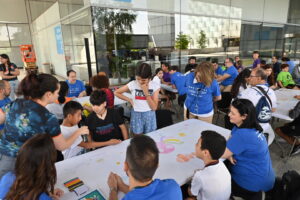
In recent decades, education has become a meeting ground (and sometimes a source of tension) between broad global policy frameworks and the local realities of schools. In this context, the OECD has played a decisive role in generating comparative knowledge and guiding educational reforms around the world. Since its inception, its purpose has been clear: to help governments design effective public policies that are evidence-based and focused on equity and quality.
The OECD has developed an educational language that is now shared by most national systems. Concepts such as “lifelong learning,” “key competencies,” and “continuing teacher training” are part of the common vocabulary of contemporary education policy. Instruments such as PISA, the Teaching and Learning International Survey (TALIS), and Education 2030 not only measure and compare, but also guide the global conversation about what it means to learn and teach in the 21st century.
But education policies only make sense when they are put into practice, and practices only change when they find the institutional, cultural, and technological conditions that make them possible. That is where ProFuturo comes in: an initiative that does not formulate policies, but puts them into practice. A program that acts directly in schools and demonstrates how global principles can become a reality in vulnerable contexts.
ProFuturo was founded 10 years ago with an eminently practical goal: to reduce the educational and digital divide through technology and teacher training. Its Theory of Change focuses on the digital transformation of primary education in low-resource environments. It does so through a comprehensive model that combines teacher training, technological equipment, teaching resources, learning platforms, and techno-pedagogical support.
But how do the OECD’s global vision and ProFuturo’s local action in digital educational transformation fit together? And, above all, what can they learn from each other?
The convergence between the OECD and ProFuturo illustrates a fundamental principle of contemporary education: global policies and local practices are not separate spheres, but complementary dimensions of the same process.
Five key convergences
Equity and diversity: the same goal from two perspectives
For years, the OECD has insisted that equity is at the heart of education systems that aspire to excellence. Equity, however, does not mean homogeneity. In its broadest interpretation, it means recognizing differences and acting on them so that none of them determines a person’s educational destiny.
ProFuturo shares this same premise, but from a practical standpoint. Its interventions are aimed at rural schools, communities living in poverty, territories in conflict, and regions with a structural deficit of resources. There, equity is not a statistical goal but a daily urgency.
The program translates the OECD’s recommendations into adaptive strategies: it adjusts technology to contexts, adapts content to local curricula, and accompanies teachers in their own process of digital appropriation. In this sense, its work embodies the idea, very present in OECD reports, that equity is only achieved when policy is sensitive to the social and cultural diversity of contexts.
In line with Sustainable Development Goal 4, ProFuturo and the OECD agree that achieving equal opportunities does not mean treating everyone the same, but rather offering each person what they need to learn.
Evidence and pedagogical innovation: learning from what works
One of the most distinctive features of the OECD is its advocacy of evidence-based education policy. Its international frameworks are based on comparative data, indicators, and empirical analysis that identify patterns of success and guide decisions.
ProFuturo adopts the same logic, but applies it to its institutional practice. Its Theory of Change is not a static document, but a continuous learning process. The program’s teams collect and analyze data on the implementation of its projects in Latin America and Africa, measure the impact of teacher training, evaluate the acquisition of digital skills, and adjust their strategies based on the results.
This empirical approach brings it closer to the OECD, but with one fundamental difference: while the OECD observes and compares education systems, ProFuturo transforms them from within. Both share the idea that improvement depends on identifying effective practices, but ProFuturo adds an experimental component that turns evidence into practical innovation.
The OECD’s Education 2030 and Teaching and Learning International Survey (TALIS) programs seek precisely that: to build a knowledge base to guide action. Within this framework, ProFuturo acts as a living laboratory for educational innovation, providing data and insights that can feed into international agendas.
Teacher training and leadership: the heart of change
No educational transformation is possible without prepared, motivated, and supported teachers. In this sense, both the OECD and ProFuturo agree on placing teachers at the center. The OECD has repeatedly pointed out that the quality of an education system cannot exceed that of its teachers.
ProFuturo has turned that statement into everyday practice. Its professional development programs combine pedagogical training with digital training and are based on a model of continuous support that, beyond offering courses or resources, consists of creating learning communities that strengthen teachers’ professional autonomy and pedagogical leadership.
On this point, there is complete agreement with the OECD: teacher improvement must be continuous, collaborative, and contextualized. Both organizations understand training not as a bureaucratic requirement, but as a process of collective growth.
ProFuturo also adds an important dimension: techno-pedagogical support, which allows technology to be integrated into daily practice without teachers losing their central role. As the OECD points out, digitization cannot replace human mediation, but rather reinforce it. ProFuturo demonstrates that this is possible, even in the most challenging environments.
Purposeful digital transformation: technology at the service of learning
Technology has become an unavoidable part of contemporary education policy, but it also poses a risk if adopted without pedagogical sense. The OECD has repeatedly warned of the dangers of digitizing traditional methodologies without changing the teaching model.
ProFuturo shares this concern. That is why its proposal is not based on technological fascination, but on the intentional use of technology as a means to improve teaching and learning. Through accessible online and offline platforms, universal digital resources, and active methodologies, the program seeks to personalize the educational experience and expand opportunities for access to knowledge.
In fact, ProFuturo operates at the intersection of innovation and equity: it introduces technology where the lack of resources or connectivity makes it most necessary, demonstrating that digital transformation should not widen gaps, but rather reduce them.
This vision coincides with the OECD’s agenda, which promotes inclusive digitization, focused on 21st-century skills and the development of global citizenship. Both institutions converge on a central idea: educational technology only makes sense if it expands the right to learn.
Assessment and continuous improvement: measuring to learn
A commitment to evidence inevitably leads to assessment. But neither the OECD nor ProFuturo sees it as a control mechanism, but rather as a tool for learning.
The OECD’s comparative assessment systems, from PISA to Education at a Glance, seek to identify trends, diagnose problems, and guide improvements. ProFuturo takes a similar approach at the institutional level: it has developed its own monitoring and evaluation systems, in collaboration with partners such as SUMMA, which allow it to analyze the program’s impact and provide feedback on its strategies.
The value of this practice lies in its formative function: the results of the evaluation feed into improvement processes, reinforce transparency, and consolidate an evidence-based organizational culture. In a context where many educational interventions are based more on intention than on evidence, ProFuturo provides an example of how evaluation can become an instrument of collective learning.
ProFuturo as a strategic partner of the OECD
The latest trends at the OECD point towards a decentralization of the educational approach: from the national policy level to the school level. The interest in identifying and disseminating good teaching practices reflects a more nuanced understanding of where improvement really occurs.
In this context, ProFuturo is a natural and complementary ally.
While the OECD produces global knowledge, ProFuturo translates it into local action. Its comprehensive model approaches the school as a learning organization: it intervenes in teacher training, school management, pedagogical leadership, and institutional culture.
This systemic perspective allows educational complexity to be addressed without reducing it to isolated factors. ProFuturo not only provides technology or training, but also strengthens schools’ capacity to sustain their own improvement process.
Experience accumulated in dozens of countries shows that sustainable change comes not only from policy, but also from practice. The OECD and ProFuturo share this conviction: systems are transformed when schools learn.
Therefore, dialogue between the two experiences is not only desirable but necessary. The OECD can find in ProFuturo a source of practical and contextualized evidence; ProFuturo, in turn, can strengthen its legitimacy and scalability by aligning itself with the organization’s international frameworks.
Essential feedback
The convergence between the OECD and ProFuturo illustrates a fundamental principle of contemporary education: global policies and local practices are not separate spheres, but complementary dimensions of the same process.
The former provides vision, data, and strategic guidance; the latter, situated knowledge, everyday innovation, and execution capacity. Between the two, a bridge is built that connects reflection with action, evidence with experience, and policy with the classroom.
ProFuturo demonstrates that the principles advocated by the OECD (equity, evidence, teacher professionalization, meaningful digital transformation) can become a reality even in the most adverse contexts. And in doing so, it contributes to a global agenda that seeks not only to improve indicators, but also to guarantee the effective right to learn in the digital age.
In short, if there is one thing that both the OECD and ProFuturo show, it is that the future of education will not be decided solely in the offices where policies are designed, nor in the classrooms where teaching takes place every day, but in the ability of both worlds to come together. Because only when policy and practice are recognized as parts of the same task can education truly be transformed.






